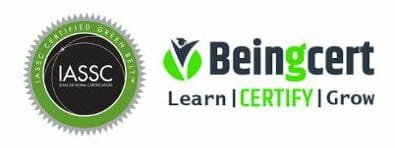Six Sigma Green Belt Training & Certification Course
Six Sigma is a collection of quality management techniques and technologies. It is a data-driven, systematic process improvement methodology for eliminating flaws in any process.

About Six Sigma Green Belt Certification
Six Sigma training focuses on developing management procedures that regularly generate near-defect-free outputs in manufacturing and other business activities. It uses a number of statistical and data analysis tools to attain this purpose. ZOC Technologies’ mission is to educate and advise professionals on Six Sigma best practices.
Six Sigma accreditation attests to a person’s mastery of a well-known approach for professional skill development. Six Sigma training certificates are issued in levels based on a karate-style belt classification system
Accredited by :

Prerequisite
- Candidates must have had a full-time, salaried position. Paid internships, co-ops, and other coursework do not count toward the required job experience.
- 3 years of work experience in one or more of the Certified Six Sigma Green Belt Body of Knowledge domains.
Six Sigma Green Belt Course Curriculum
Six Sigma Green Belt - Duration – 2 Days (16 Hours)
The accelerated Six Sigma Green Belt program and methodology allow students to complete certification requirements faster than traditional Six Sigma training programs. Successful candidates will be awarded the Six Sigma Green Belt certification from Sigma Corporation after passing the included certification exam.
The certification exam is included in this course and you can take the exam at your convenience after passing section quizzes. You must complete the exam within 6 months of class. This course, combined with a Green Belt test and demonstrable application of the tools will lead to Green Belt certification.
1 - SIX SIGMA INTRODUCTION
- Introduction to Six Sigma
- Overview Six Sigma Principles & Terminology
- Roles and Responsibilities in a Six Sigma Organisation
- Value Stream Maps
- 5S
- 7 Wastes
- Project Selection
2 - DEFINE PHASE
- Voice of Customer
- Project Charter
- Process Mapping (high level and detailed mapping)
3 - MEASURE PHASE
- Selecting Measures: Y=(f)x
- Data Collection Planning
- Baseline Data Collection
- Basic Statistics
4 - ANALYZE PHASE
- Process Analysis (Non-Value Add vs. Value Add)
- Graphical Analysis
- Determining Root Cause
5 - IMPROVE PHASE
- Lean Solution Concepts: Standard Work, Batch Size Reduction, Work Cells, Kanban, Pull Systems, and Kaizen Events
- Brainstorming Solutions to Address Root Cause
- Solution Selection, Pilot, and Implementation
- Improvement Data Capture
6 - CONTROL PHASE
- Monitoring, Revision, and Response Plans
- Mistake Proofing and Visual Management
- Replication
7 - GREEN BELT PRACTICE TEST
- Case Studies
- Quiz
- Q&A
Exam Info
- Type: Multiple Choice Questions (open book)
- Mode: Computer Delivered – The CSSGB examination is a one-part
- No. of Questions: 110 questions (100 questions are scored and 10 are unscored)
- Duration: Total time is 4 hours and 30 minutes & exam time is 4 hours and 18 minutes.
Skills You Learn
- Implement Lean Six Sigma projects
- Measurement System Analysis
- Data Analysis
- Lean Principles
- Hypothesis Testing
- Process Analysis
- DFSS tools
Key Features
- Certification is Accredited by Beingcert/ IASSC- Our Authorised Partners
- Deliverables : Courseware, Question Bank, Training Kit
- Authorised Study material from Beingcert/ IASSC
- Globally Recognised Certificate of Participation from Beingcert / IASSC upon course completion
- Doubt Clearing Sessions By Our Expert Trainers
- Access study resources like case studies, exercises, eBooks, mock tests, & more upto a year.
Who can join Six Sigma Green Belt Training?
- IT Professionals
- GRC Manager
- IT Developers
- Program Manager
- Business Manager
- Assurance Providers
- Risk Management
- IT Operations Manager

Six Sigma Green Belt Training FAQs
What does Six Sigma Mean?
There are several meanings for Six Sigma; here is the most appropriate one:
Six Sigma is a data-driven, disciplined strategy and technique for reducing variance in processes, which improves system performance and, in turn, leads to increased customer satisfaction and considerable financial benefit.
‘Disciplined,’ ‘data-driven,”methodology,”reduce variance,’ and ‘customer satisfaction’ are all crucial terms in the definition. The most crucial benefit is a substantial cash gain. Organizations would have little interest in implementing Six Sigma unless it yielded financial benefits.
A metric system is Six Sigma. In ascending sequence, Sigma levels 1 to 6 define the robustness of the process. The higher the Sigma number, the greater the process’ capacity to provide superior, consistent results.
The number of errors per million chances decreases as the Sigma value rises.
Six Sigma is a technique.
It includes: A method for tackling complicated issues that is clearly stated and organised.
DMAIC or DMADV techniques have been shown to work.
Six Sigma is a journey, not a destination.
While other Quality efforts concentrate on discovering and resolving faults, Six Sigma focuses on developing strong processes that remove or decrease the source of mistakes. Six Sigma works best when used over a longer period of time. It’s a quest to reach the ideal degrees of excellence.
The procedure would improve accuracy by eliminating variance in the process; hence, Six Sigma is all about Process Accuracy.
What does Six Sigma mean in Sales And Marketing?
Six Sigma may not be applicable to all aspects of sales and marketing. Tools like probability, hypothesis testing, regressions, trend analysis, forecasting, and design of experiments, on the other hand, can be quite useful. These technologies can assist in identifying and prioritizing consumer segments where the company can increase revenue.
The Lean 6 Sigma Pro team assisted one of their Technology industry clients in increasing sales by 1.75 percent, resulting in a million-dollar boost in yearly revenue.
What are the six sigma opportunities in India?
It is critical to first comprehend what Six Sigma is. There are other definitions of Six Sigma, however, this is the most applicable.
Six Sigma is a data-driven, disciplined strategy and technique for reducing variance in processes, which improves system performance and, in turn, leads to increased customer satisfaction and considerable financial benefit.
Manufacturing, automotive, food processing, healthcare, IT, ITES, and supply chains are among the industries that only fulfill the set standards 80–90 percent of the time. Large sums of money are squandered as a result of inefficient operations. Significantly lower rejection rates and millions of dollars can be saved if process variances are eliminated. A few million dollars may be added to a company’s coffers each year by good Six Sigma workers. It is a valuable resource for the industry.
Can RPA or Six Sigma be applied to healthcare professionals?
Yes, both RPA and Six Sigma may be studied by healthcare workers. It’s best to choose between the two based on the learner’s core skills; Six Sigma, at least beyond the Green Belt level, necessitates a certain level of mathematical understanding. RPA need some coding knowledge. The learner’s subject knowledge, combined with Lean Six Sigma or RPA, would be extremely beneficial to the healthcare business.

